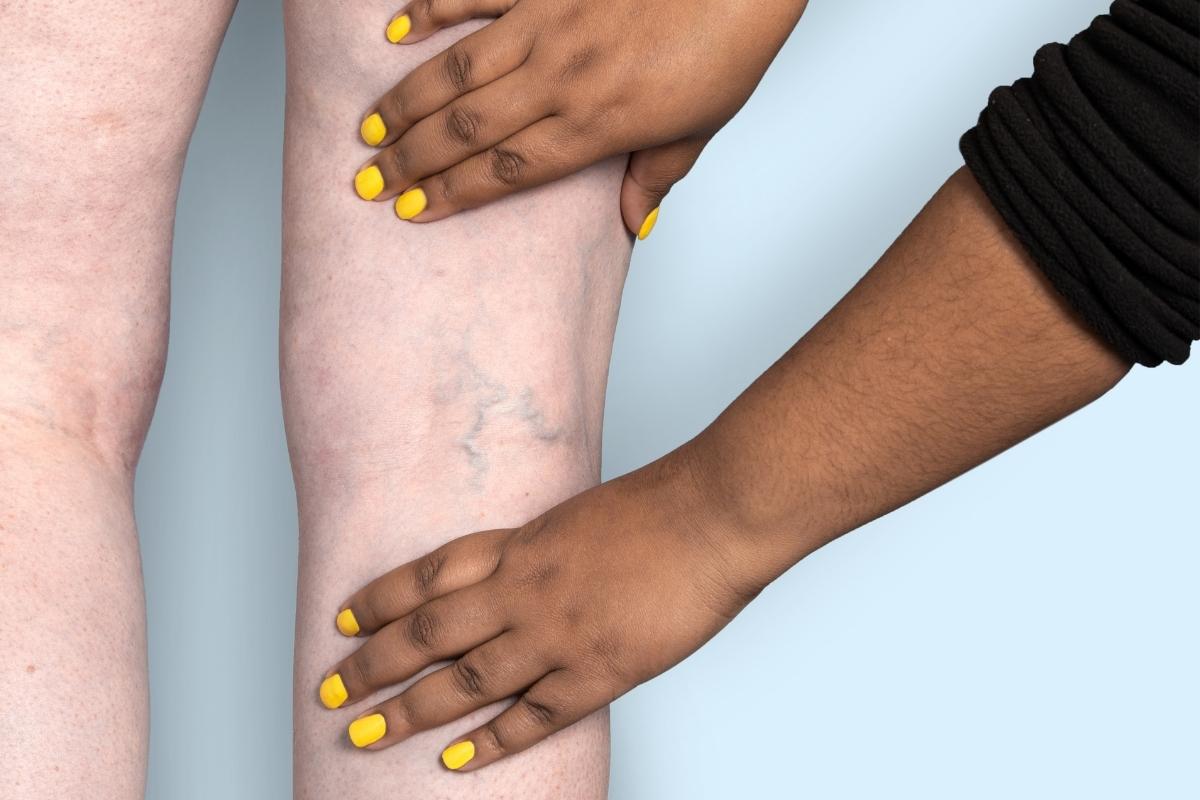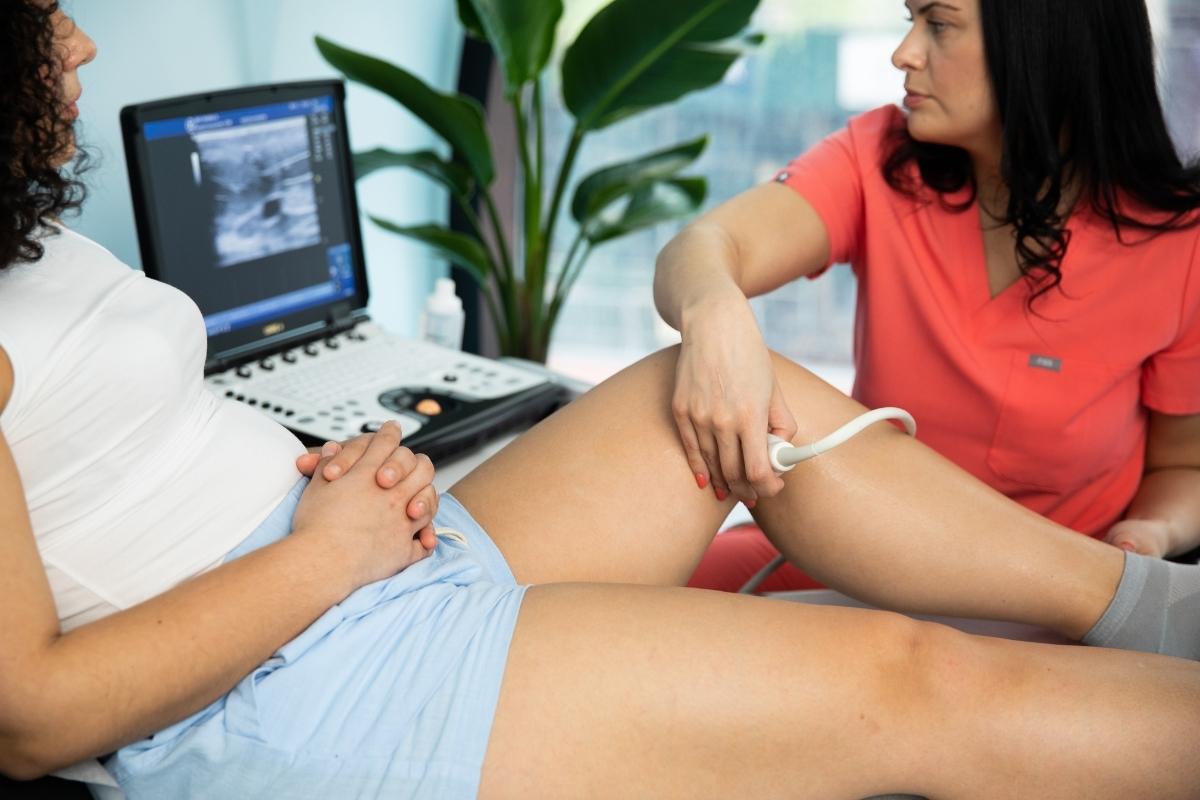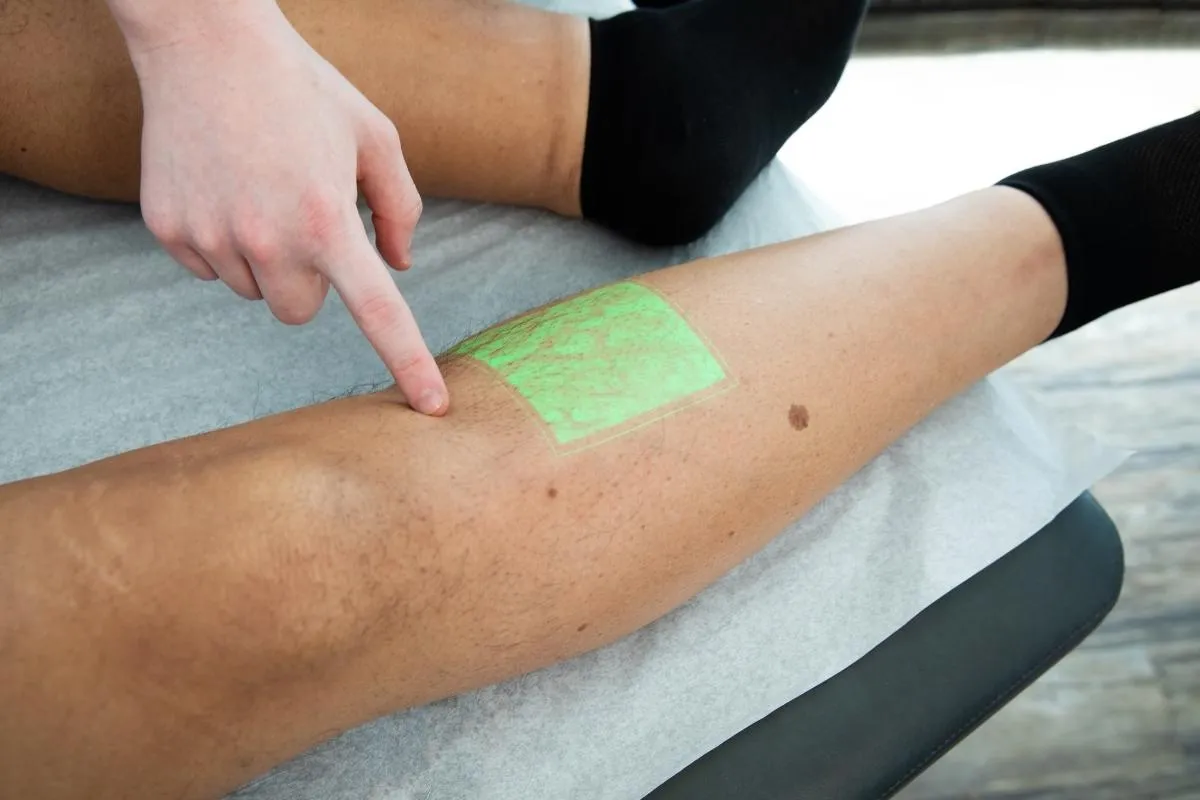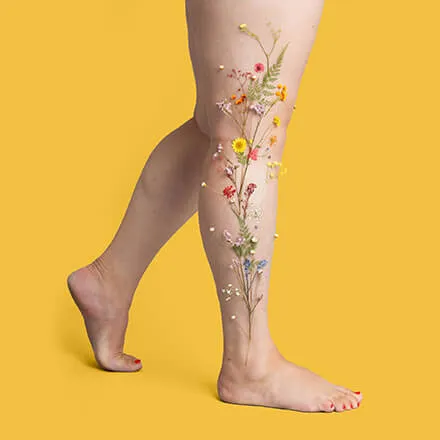Blue veins are typically normal and not a cause for concern. The blue appearance is due to how light interacts with skin and blood vessels. Factors like skin tone, age, and body fat affect visibility. Temporary causes include exercise, heat, and dehydration. While usually harmless, sudden prominence of blue veins with pain or swelling may indicate underlying vascular issues and should be evaluated by a doctor.
While researching vein disease, or simply from observing your own skin, you're likely to have noticed that you may have visible veins all over your body.
How can you tell if your visible veins are harmless or if they are signs of underlying vein disease?
We've got you covered.

Blue Veins, Green Veins, Purple Veins, and All the Colors in Between
Depending on your skin tone, you may have visible veins on areas of your body that have thinner skin; your wrists, the backside of your hands, your eyelids, and your neck may have traceable veins that skew blue, green, or even purple. The thinner the skin, the more likely you are to be able to see what is sitting just underneath the surface with the naked eye. But why do these visible veins appear blue, green, or purple when our blood is red? This is largely due to the undertone of your skin. People with a cool undertone, many of whom feel silver jewelry looks best on them, may see their veins as blue or purple, while people with a warm undertone, many of whom feel gold jewelry looks best on them, tend to see their veins as green or bluish-green. And depending on the depth of your skin tone, it's perfectly normal to not be able to discern your vein color, or to not be able to see your veins at all.
The color of your veins, or their visibility at all, is not necessarily indicative of greater health concerns such as varicose veins or venous insufficiency. Your veins are visible because of the color of the light your blood and skin reflect back to your eye. The human eye can view a limited spectrum of color, but our brains can only process what color on that spectrum is reflecting back to our eye. If you see a pink flower, it is because the flower has absorbed all other colors and reflects pink. Brown trees absorb all colors except for brown and reflect that color into our eye. The same is true for the hemoglobin in the deoxygenated blood traveling through your veins. Your veins reflect a dark red, but your skin tends to reflect more blue than red, creating a strange optical illusion that causes our veins to appear blue, green, or purple despite the redness of our blood!

How Bodily Changes Affect The Visibility Of Your Veins
As we age, our skin loses elasticity. This causes cosmetic changes to our skin such as wrinkles, sagging, and thinning on areas where our veins may have previously been harder to see. The amount of body fat you carry also impacts how easily you can see your veins without the aid of ultrasounds or vein lights--the less body fat you have, the more visible your veins may be! Depending on the structure of your skin, your weight, and your age, you may have perfectly harmless and non-concerning visible veins.
Our bodies change constantly, and it's important to monitor the changes you see in case they may be indicators of health concerns. If your visible veins come paired with some of the common symptoms of vein disease, it may be time to visit a board-certified vein doctor.
· New discoloration, such as darker red/purple patches. This may indicate Deep Vein Thrombosis.
· Swelling of the legs. This may point to poor circulation or weakened vein walls and valves.
· Pain or discomfort (itching, burning, cramping, restless legs, tingling sensations). No pain is normal, so new or worsening pain should always be taken seriously.
· Bulging, twisted veins. Varicose veins can be visible on the surface of the skin, and may increase your risk of blood clots.
· Formation of ulcers or open wounds. Ulcers often form as a direct result of extremely weak circulation, or because of pooling blood from damaged or backward-flowing vein valves.
Taking a regular inventory of your health and the effects it has on your veins will aid in how easy it is to notice changes in your body, including the symptoms of vein disease that are apparent on the surface of the skin. Take a moment to investigate your legs while applying lotion, changing into your pajamas, or rolling up your socks. If anything has changed, or if you have any concerns, give your vein doctor a call. We're happy to help!

What If I Can't See My Veins?
The darker your complexion is, the more difficult it can be to see your veins. There are, however, alternative ways to monitor your veins for symptoms of vein disease. Skin that is warm to the touch, unbalanced swelling in only one leg, patches of purple or deep red discoloration, and bulging veins are all symptoms that can be noted despite the lack of visible blue, green, or purple veins under the skin. The utilization of vein lights and vein ultrasounds can also provide a clearer picture of the veins beneath your skin. Metro Vein Centers guides all of our FDA-approved vein treatments with ultrasound technology to ensure all veins--visible and invisible to the naked eye--can be monitored and evaluated by our team of vein doctors.

Are All Venous Issues Visible Like Blue, Green, and Purple Veins?
Some venous insufficiencies, such as spider veins and bulging varicose veins, are easy to spot without state-of-the-art medical equipment like ultrasound machines or vein lights. However, it's important to note that not all visible veins are vein disease. Spider veins, on a surface level, are a purely cosmetic concern and can be treated with minimally invasive or 100% non-invasive vein treatments like excel V+ laser, sclerotherapy, or other vein injectables. Red veins in a web-like pattern can be easily treated and are not always cause for concern. If your spider veins are paired with symptoms of vein disease, they may play a factor in identifying medical concerns such as varicose veins. Varicose veins, while visibly quite different from spider veins, can also be reddish in hue, but do not appear in thin, web-like structures; varicose veins are more often bulging and twisted, and are usually much larger in comparison.
Deep Vein Thrombosis, or DVT, occurs in deep veins that are surrounded by muscle and tissue and cannot be seen by the naked eye. Deep Vein Thrombosis often showcases some visible symptoms such as swelling and discoloration. Another DVT symptom is tangible heat on one leg only. DVT can also occur without visible symptoms, just as some varicose veins occur deeper or without bulging against the skin. Deep Vein Thrombosis and the formation of blood clots in your deep veins greatly increases your risk of developing a very serious and potentially life-threatening complication called pulmonary embolism, where blood clots break free from damaged vein walls and clog the arteries in your lungs. This can occur without visible symptoms, or with symptoms that do not impact the color of your veins.
Just because you can see your veins does not mean they are affected by vein disease, and just because you cannot see your veins doesn't mean they are as healthy as one might expect. The only way to know for sure is to be evaluated by a board-certified vein doctor near you.

How Do I Take Care Of My Veins?
The same advice is true across the board when dealing with prevention and care of vein disease. There isn't much that can be done to conceal visible blue, green, or purple veins from a medical standpoint, as they are often harmless. However, if you're worried about your visible veins due to the appearance of new symptoms, here are some ways you can improve the health of your veins.
· Regularly take part in low-impact or light exercise.
· Quit smoking.
· Maintain a healthy weight.
· Wear compression stockings.
· Elevate your legs to improve circulation.
· Seek the opinion of a vein doctor if you notice new or worsening symptoms.
There are many unavoidable factors at play in who is more likely to develop vein disease than others, but luckily the visibility of blue, green, or purple veins is not one of them. Variables such as age, genetic predisposition, family history, and whether or not someone stands or sits for extended periods of time can impact the health of their veins. If you can see your veins on areas of your skin that are thin, or if your complexion is a bit translucent in areas, this should not be cause for concern.

Understanding Your Veins From The Outside-In
Visible veins, while not always visible due to vein disease, can always be evaluated by a vein doctor. Our passionate staff of board-certified vein specialists offer free evaluations for all of our patients in each of our vein clinics in New York, New Jersey, Michigan, Connecticut, and Texas. Blue, green, or purple veins may only be visible due to the thickness of your skin or the fairness of your skin tone, but if your veins are bulging in your legs or if you are experiencing sudden discomfort or pain, our vein doctors are here to help.
There are many FDA-approved vein treatments that target or remove varicose veins and spider veins. Sclerotherapy, VenaSeal, Varithena, and Radiofrequency Ablation are all minimally invasive treatment options for removing varicose veins. If your concerns with your visible veins are purely cosmetic, our state-of-the-art vein clinics offer excel V+ laser treatments to remove spider veins. This 100% non-invasive vein laser delivers penetrating pulses of light energy directly into spider veins and can improve the appearance of skin discolorations.

Our vein doctors focus on providing the highest quality, customized and patient-centric care to everyone who walks through the doors of our vein clinics. Claim your free evaluation today by calling 866-831-9522. Our vein doctors will be happy to walk you through the ins and outs of your veins--blue, green, purple, or otherwise!
We look forward to seeing you at one of our Metro Vein Centers vein clinics soon!

Metro Vein Centers Editorial Team
From vein care 101 to treatments, the Metro Vein Centers blog offers patients everything they need to know about vein health.

Trusted insight from the nationally accredited, board-certified vein doctors at Metro Vein Centers.







